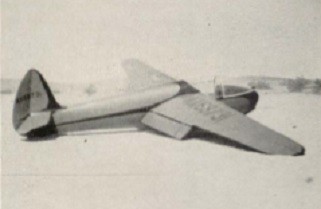Ramon H. Parker
1964
about
(1914-1980) SSA Director; Sailplane Designer/Builder; Thunderstorm Project; Sierra Wave Project Pilot; US Team Assistant Captain 1956; National Competition; WWII Glider Instructor
Awards
Silver #36 1941; Gold #6 1946; Diamond #4 (Int #8) 1952
Bio

When most of us fascinated by the idea of flight were jumping off roofs, Ray Parker, at age 13 and in the eighth grade, was building and flying a primary glider. After he was helped down (by the truant officer) from a tree in which he had landed, he never did return to school. Most of his talents as a wood worker, painter, and pilot were already far in advance of his years.
During the Great Depression, he was in the Civilian Conservation Corps where he built models and dioramas for museums. Some are still on exhibition. About this time, he walked out of his first class in oil painting before it was over. As a self-taught artist, he painted many fine canvases of landscapes (all Western scenes), not to make a living form them, though some sold for good prices, but to satisfy his artistic urge and gratify his friends.
Ray flew gliders in competition in Southern California during the years before WW II. When this country began training pilots for assault gliders, Ray was quickly recognized as a natural. He instructed initially at Elmira and then at Twentynine Palms Gliding Academy. Ray was selected by the USAAF as an instructor in basic trainers and became a civilian power plane instructor of military cadets until the end of hostilities.
During the summer of 1946, he toured the land with his old friend Johnny Robinson. They entered one soaring contest after another and lived off the considerable prize money they won. The following year he opened a school for soaring at Twentynine Palms, but this effort ended in a violent windstorm after a couple of seasons. At that time, Dr. August Raspet was starting the Department of Aerophysics at Mississippi State University and hired Ray to fly research aircraft for a time.
Ray brought his family to Los Angeles in 1951 and was hired by the Southern California Soaring Association, which was preparing to explore waves in the lee of the high Sierra Nevada. This project was sponsored by the USAF and directed by the University of California's meteorology department. Initially Ray directed the refurbishment of two Pratt-Read sailplanes (war surplus Navy trainers) and equipped them with oxygen and instruments for the explorations into the stratosphere. He then became Director of Field Operations, with his old friends Johnny Robinson and Larry Edgar serving as project pilots. Much of the success of this complicated and risky endeavor was due to Ray's mature leadership, judgment and planning.
Following the completion of the Mountain Wave Project, Raspet called him back to Mississippi State for a two-year stint of test flying and aircraft modification. In 1955 Ray hired on as a specialist in instrumentation of jet engines at AiRsearch Company in Los Angeles. There he remained until his retirement.

In an effort to improve on his Screamin' Wiener design, Ray built much of the Tiny Mite (although it turned out very different) which he sold to Dick Johnson while still under construction.

His devotion to, and involvement with, soaring are evident in the things he accomplished: Assistant Team Captain of the 1956 U.S. International Team; crewman for other U.S. Team pilots; rebuilding of the Polish Orlik, a 1938 gull-winged beauty; modification of the Tiny Mite to bring it (with Raspet's assistance) from 25:1 to 31:1 L/D; the design and construction of his T-Bird, the Stradivarius of wooden sail- planes; his service as chief instructor and president of the Southern California Soaring Association.
Ray earned Silver #36 in 1941, Gold #6 in 1946 and Diamond #4 (Intl # 8) in 1952.
Above adapted from an article by Vic Saudek, Soaring, July 1980, page 37.